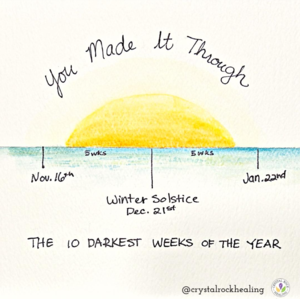With the Christmas season over and the sparkle of New Year's Eve in the rearview mirror, do you feel like Winter is dragging on with no end in sight? Research shows that seasonal affective disorder (SAD) targets a disproportionate percentage of North Americans. Approximately two to three percent of Canadians experience SAD, while 15 percent experience a milder form of SAD, which can still impact their lives to a lesser degree. Closer to home (Red Deer), we understand that SAD is more prevalent in regions with significant seasonal daylight changes, like Alberta. Our long, dark winters make Albertans more susceptible to the winter doldrums. The good news is that the end is near! You have made it through the 10 darkest weeks of the year, from November 16th to January 22nd.
How can you get through the rest of Winter and prepare for next year? Do you sink into the misery, hunker down, and eat massive amounts of carbs? While some of these options might be appealing, what if you considered a mindset switch? For the two to three percent who experience more severe symptoms of SAD, a mindset switch might feel invalidating, so hear me out!
Several years ago, after the birth of my second child, I suffered from postpartum depression combined with my typical SAD symptoms: hopelessness, low energy, oversleeping, overeating, irritability, and loss of interest in activities that typically brought me joy. Needless to say, I was not coping well. I sought therapy for the first time in my life, and my postpartum specialist suggested I get to the root of my symptoms. She uncovered that during the Winter, the long nights evoked feelings of fear, dread, and anxiety. I was so focused on finding a target for these uncomfortable feelings that they only grew bigger and bigger.
My wonderful therapist invited me to participate in a simple exercise that involved attaching new meaning to the darkness associated with Winter and nighttime in general. I started to see it as a time to pause and enjoy being at home, cozied up with a warm, fuzzy blanket, feeling safe in my heated home—safe from the ravages of Winter. It became a time to enjoy grounding activities, such as reading a good book, playing board games, and journaling. I was learning to change my relationship with my stressful thoughts about Winter.
In addition to my experience, a therapist colleague shared that the last two years have been particularly challenging for her clients and herself. Even with a greenhouse atmosphere in her home and multiple SAD lights (which mimic natural sunlight), she has struggled. She described feeling the "post-graduate school blues," a sense of disillusionment that can follow extensive studies, compounded by a cloudy winter. Next year, she plans to focus on outdoor activities, avoid social media—which she admitted exacerbates her low mood—incorporate mindfulness practices, and possibly take a trip to a sunnier location. She admitted that discussing antidepressants with her doctor is also on her list. By prioritizing these changes, she hopes to combat SAD more effectively and inspire her clients to do the same.
I want to say that magically, my SAD disappeared; however, this is not true. It has taken many years to lessen the grip that SAD has had on my life. Like everything in life, progress over perfection is encouraged. I have learned new ways to manage SAD. Yet, still, during some winters, I did backslide into a more profound depression, and I found the following tips invaluable.
Here are the top five ways to manage Seasonal Affective Disorder (SAD):
- Therapy: Expose yourself to a light therapy box that mimics natural sunlight. This can help regulate your body's internal clock and improve mood.
- Exercise: Regular physical activity, especially outdoors, can boost serotonin levels and improve overall well-being.
- Maintain a Healthy Diet: Eating a balanced diet with plenty of fruits, vegetables, and whole grains can help stabilize your mood and energy levels.
- Stay Connected: Socialize with friends and family, even virtually. Maintaining social connections can provide emotional support and reduce feelings of isolation.
- Seek Professional Help: If symptoms are severe or persistent, consider talking to a mental health professional for therapy or medication options.
I cannot emphasize enough the importance of these five ways to manage SAD. If you belong to the two to three percent who experience severe SAD symptoms, seek support from your medical doctor and consider finding a therapist to help guide you through the dark and dreary months of January to March. If you belong to the other 15 percent, capitalize on tips one through four to help bolster your mood. Of course, you can also benefit from regular doctor's appointments and a therapist to prevent yourself from falling into the two to three percent of the population. SAD can also occur in summer, so pay attention to your seasonal patterns. But for now, move towards ways that flip the light switch back on during this season of darkness!

Cheri Morrison Judson
Contact Me